The mission statement for the GAH and Community Clinic
The mission of the GAH and Community Clinic is to enhance the health of the general community by setting high standards in patient care.
We aim to achieve a smooth shift from hospital to community-based care for the aged.
The organizational diagram depicting the organizational structure of the existing Mission Hospital, Children’s hospital, and the proposed Golden Age Hospital, and the Community Clinic.
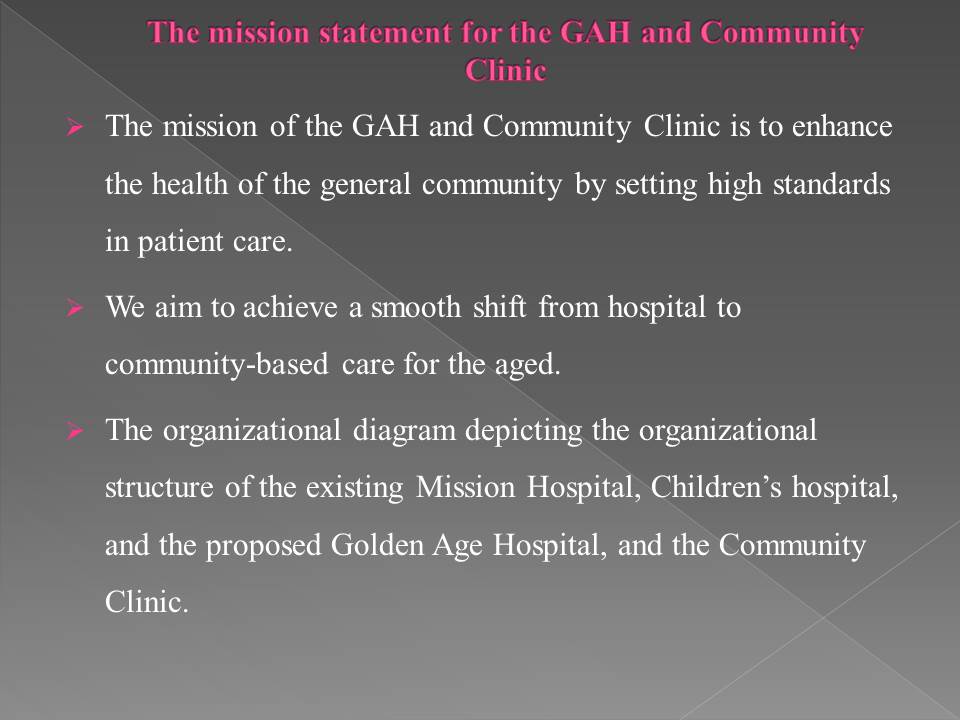
Organizational Structure
- It is important to note that all hospitals will fall under the existing MVH.
- That is, where required the GAH/CC will be referring patients to MVH.
- It must be understood that although the hospital mainly serves the aged, other people also access these services.
- Moreover, most of the services included in the diagram above are offered by each individual health center.
- However, the three health care facilities share information systems, medical laboratory, imaging, emergency medicine, cardiology neurology and blood bank.
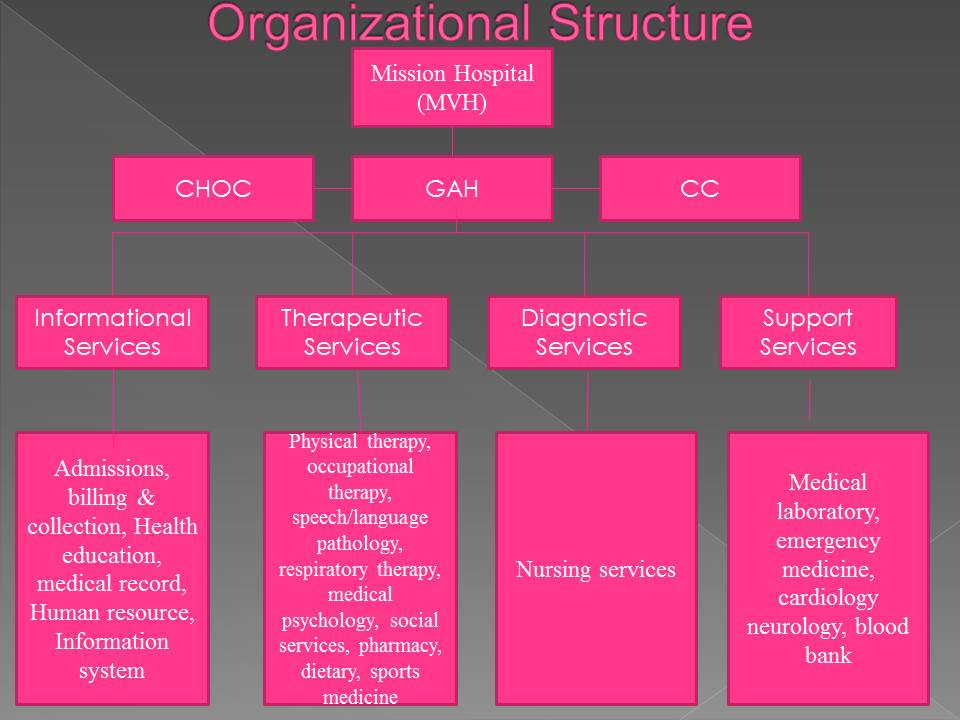
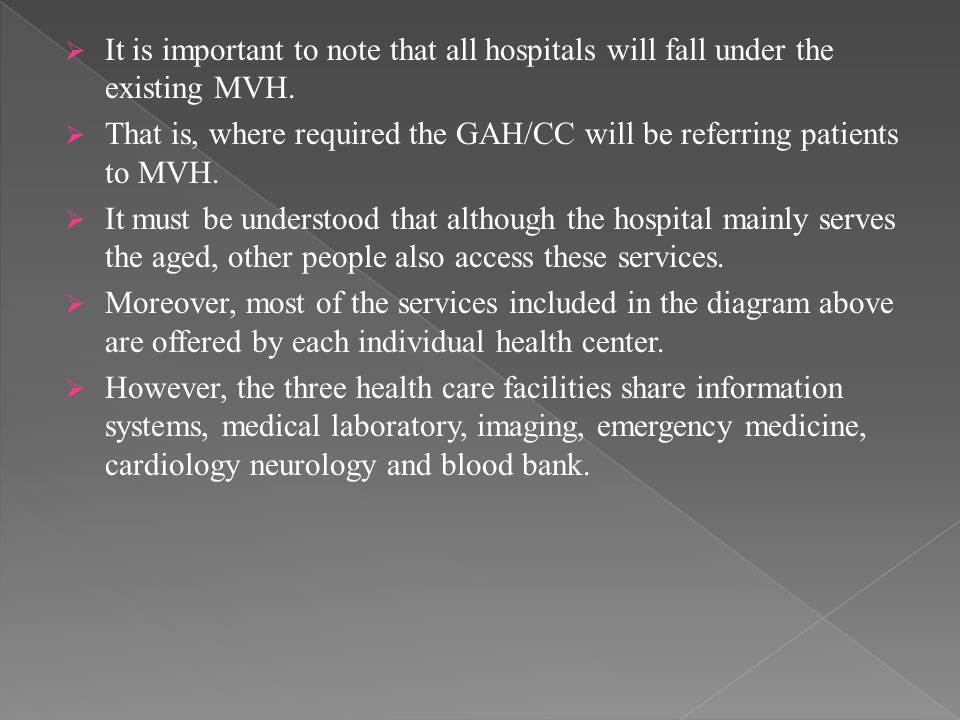
Organizational relationships between the structure blocks
Other than the services they share, the other relationship is purely administrational (Simonet, 2005).
This include the hospital president, vice president, executive assistants and departmental heads (Pitts, Carrier, Rich & Kellermann, 2010).
The health centers relate in the sense that they are headed by one president. Each health care center is managed by a vice president who reports to the president.
Thus, the president oversees the operations of all the hospitals. He specifically ensures that these facilities are delivering the most appropriate, safest as well as highest quality care to all patients regardless of the financial capability (Robinson & Ginsburg, 2009).
All heads of departments, as well as freestanding hospital vice presidents report to the hospital president.
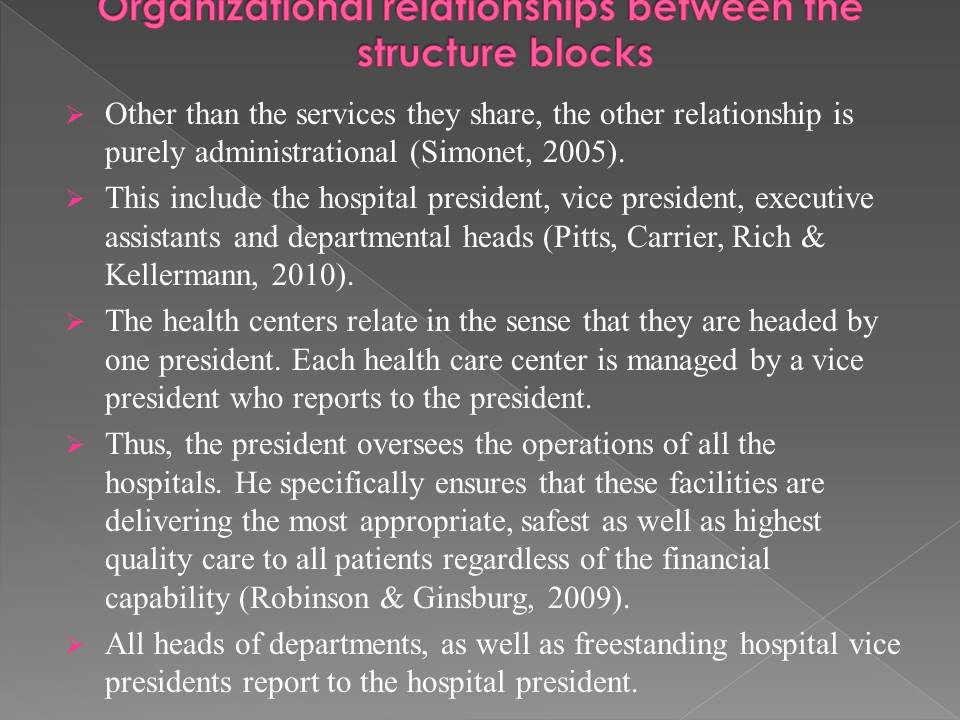
The number of beds at the hospital
Golden Age Hospital (GAH) will have about 200 beds, while the community clinic will have about 70 beds.
Beds have been allocated based on the population in the area; a retirement community of more than 23,000 residents aged 55 and older is served by the Golden Age Hospital (GAH).
The facility is allocated 200 beds, and retirement community of more than 3,000 residents age 55 and older which is served by the community clinic is allocated less number of beds respectively.
With this, beds have not been allocated based on the number of patients it can admit.
It must be recognized that being a hospital under an existing referral hospital, most complicated cases will always be referred to the former.
The community clinic will mostly handle delivery cases, but in the case of a major operation, the patient will be referred to the main referral hospital.
In addition, when there are many patients at the newly established centers.
The alternative is not to expand to number of beds or wards.
The best alternative under the existing arrangement is to refer them to other hospitals that fall under our organizational structure.

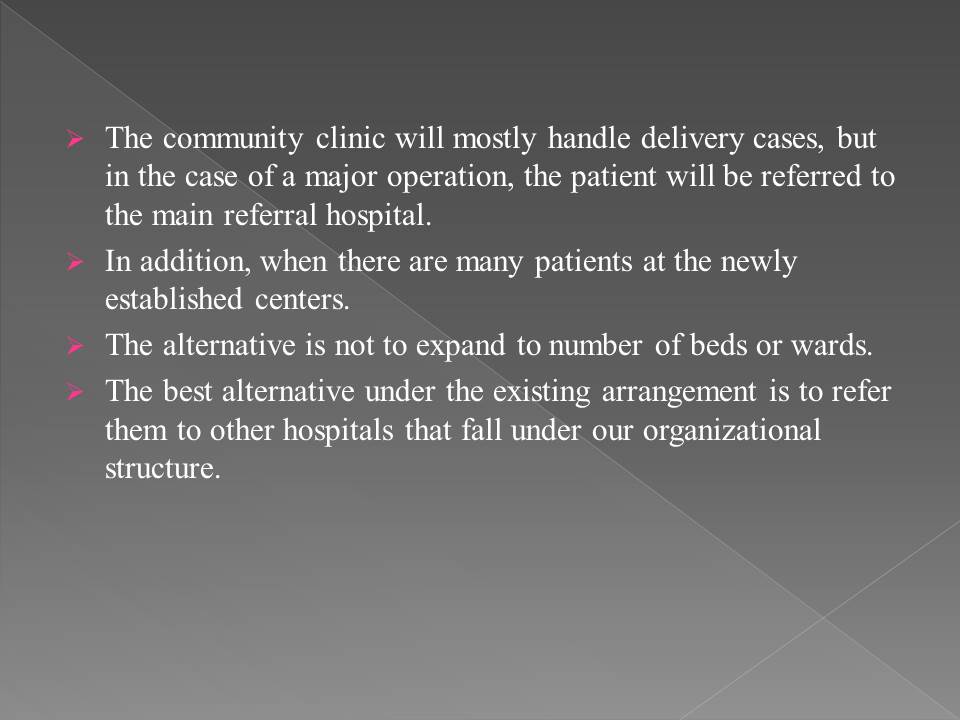
Services will include social, clinical and general services
Admissions
- Under this section, the responsibilities will include: obtaining vital information from patients.
- That is, the names of patients, addresses, phone numbers, admitting doctor, admitting diagnosis, social security numbers, all insurance information and date of birth.
- Frequently admission will also assign patients (in house) their rooms.
Billing and collection section
- This will be responsible for billing patients for the services offered.
Medical records
- This department will be responsible for keeping the records of all patients who have been served by the hospital.
Informational services
- This is the section that will be responsible for documenting and processing information.
Information system
This is the IT department responsible for computers and maintaining hospital networks.
Health education
- This department will be responsible for patients and staff health-related education.
- This information may be generally intended to persuade the target population to change their lifestyle or just teach them something to help in managing their health (Robinson, 2005).
- In general, health promotion or health education is a very important aspect for work of medical practitioners as they develop and avail inclusive interventions that are sensitive or conscious to the target population.
Human resources
This will be responsible for hiring, firing and remunerating employees.
Diagnostic services
This determines the causes of illness and even injuries. It will be organized into two departments:
Medical laboratory
Will be used to study bodies to determine abnormalities
Imaging
Image body parts to determine abnormalities and lesions
Hospital administration
They manage the operations and functions of the departments. They oversee budgeting and finance, set up hospital procedures and policies, and undertake public relation duties (Kurtzman, 2010).
As it has been seen, they include the hospital president, vice president, departmental heads, and executive assistants.
Therapeutic services
It includes the following departments:
Physical therapy
- This department will provide treatment to enhance large-scale mobility of muscles and limit or prevent permanent disability.
- Treatment may include massage, exercise, ultrasound, hydrotherapy, heat application and electrical simulation.
Occupational therapy
- The main aim of setting up this department is to assist patients regain fine motor skills to enable them to function autonomously both at the place of work and home.
- Here, the treatment may include, but not limited to, arts and crafts that assist with hand eye coordination, and social activities to assist emotionally disturbed patients.
Speech and language pathology
- Identify, assess and refer or where necessary treat patients with speech and language challenges.
- It will also assist patients to cope with challenges associated with language and speech impairment.
Respiratory therapy
- Since our hospital is new, it will only diagnose and refer patients with lung and heart complications.
- However, in the cases where the condition of the patient is not critical, the treat at our facility will include oxygen and breathing exercises.
Medical psychology
This section will be concerned with the patient’s wellbeing. The treatment will include talk therapy, muscle relaxation, behavior modification, group therapies.
Social services
Help patients by providing them with community resources such as housing, financial and medical help.
It will also offer social work specialties such as geriatrics, child welfare, family correctional on a case to case basis. Under geriatrics, the following services will be offered:
- Dedicated outpatient services that will help to meet the particular needs of older persons such as outpatient falls as well as a mental health services for elderly people.
- A designated geriatric unit to offer services such as restorative and rehabilitation care, and comprehensive inpatient assessment for patients who are suffering from functional loss that is reversible.
Pharmacy
- The main function of this section is to dispense medications as per orders written by physicians.
- It will offer information on drugs and the correct way of using them. Last but not the least, it will ensure compatibility of drugs.
Nursing
This department will provide care for patients as instructed by physicians. Nursing specialties comprise labor and delivery nurses, nurse practitioner, neonatal nurses, nurse midwives, and emergency room nurses.
In our case, nurse anesthetist and surgical room nurses will only be asked when a minor operation to be carried out. Any complex operation will always be referred to MVH.
Support services: This department will offer support to all hospital sections. It will include the following sections.
Central supply: It will be in charge of ordering stocking and distribution of all equipments used by the hospital.
Biomedical technology: It will be offering preventive maintenance to all hospital equipments. It will also carry out pilot use of equipments before they are distributed for use by staff.
Housekeeping: Maintain clean safe environment. Personnel in this section include electricians, cleaners and carpenters.
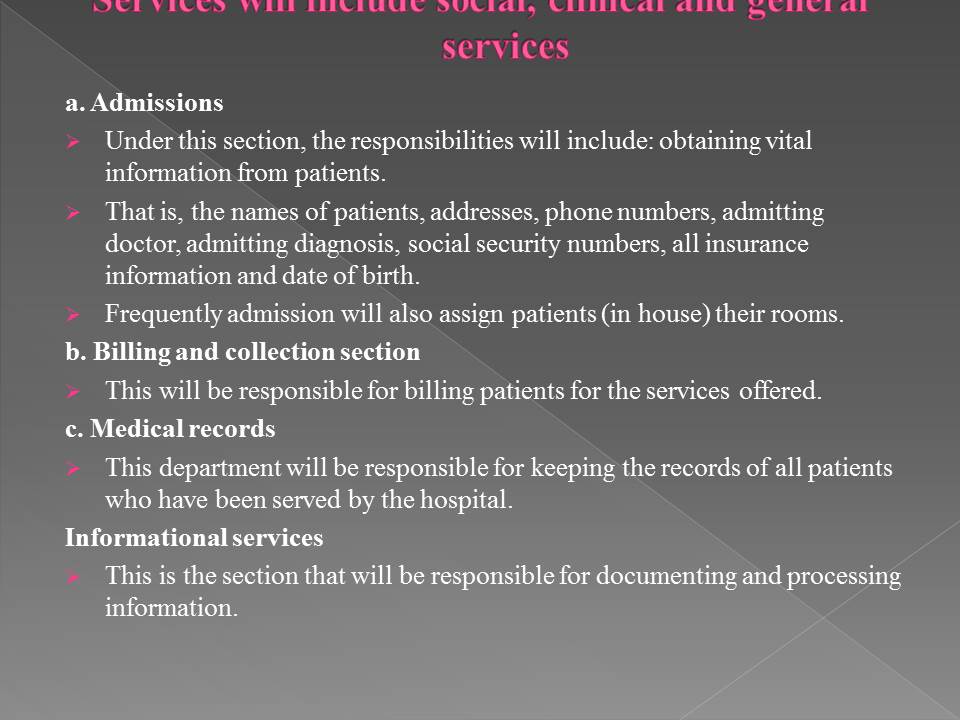


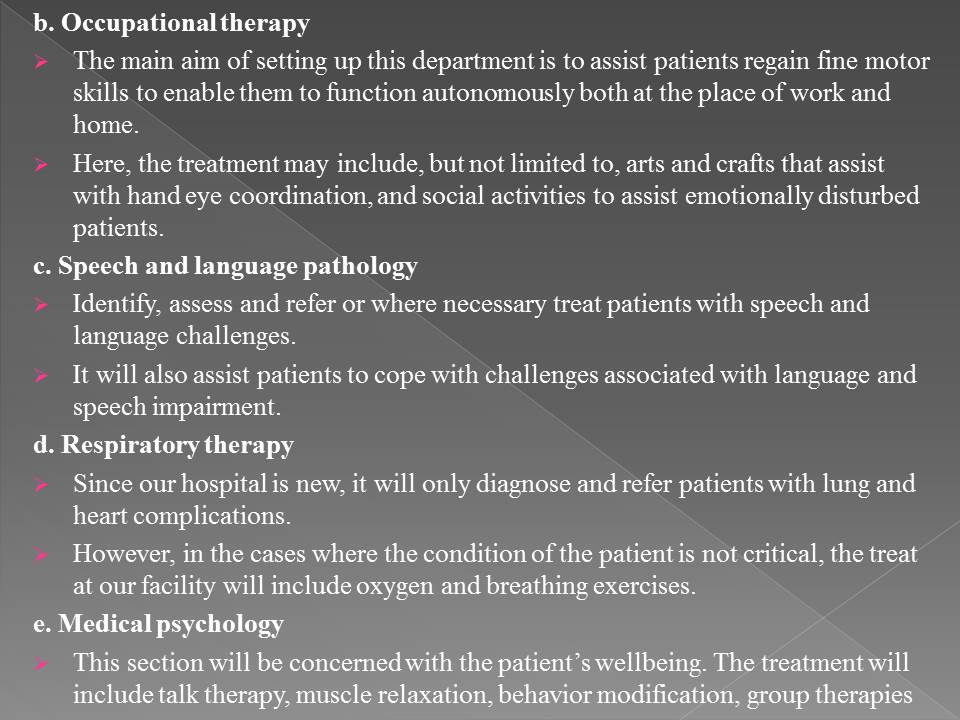
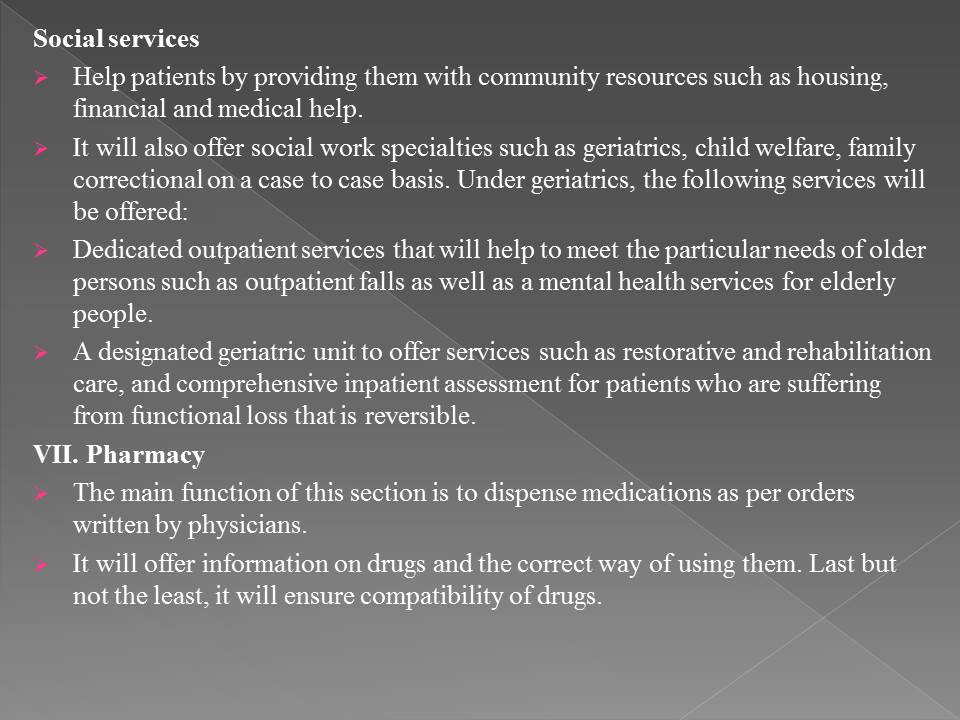

Integrating the services of geriatricians within the GAH/CC
It is important to appreciate that smaller hospitals may not provide a wide array of geriatric services.
Such hospitals will still admit a sizeable number of older people suffering from psychosocial issues or acute conditions. In this case, integration is necessary (Shi, Lebrun & Tsai, 2008).
Access to any geriatrician, who may be needed to offer an outreach service, integration will be done through the use of videoconference, teleconference, or web-based technology.
The hospital may also offer both an integrated geriatric consultancy service and a dedicated geriatric unit.
However, as the hospital develops and assesses its real workload, other advanced models of integrating GAH/CC will be adopted.
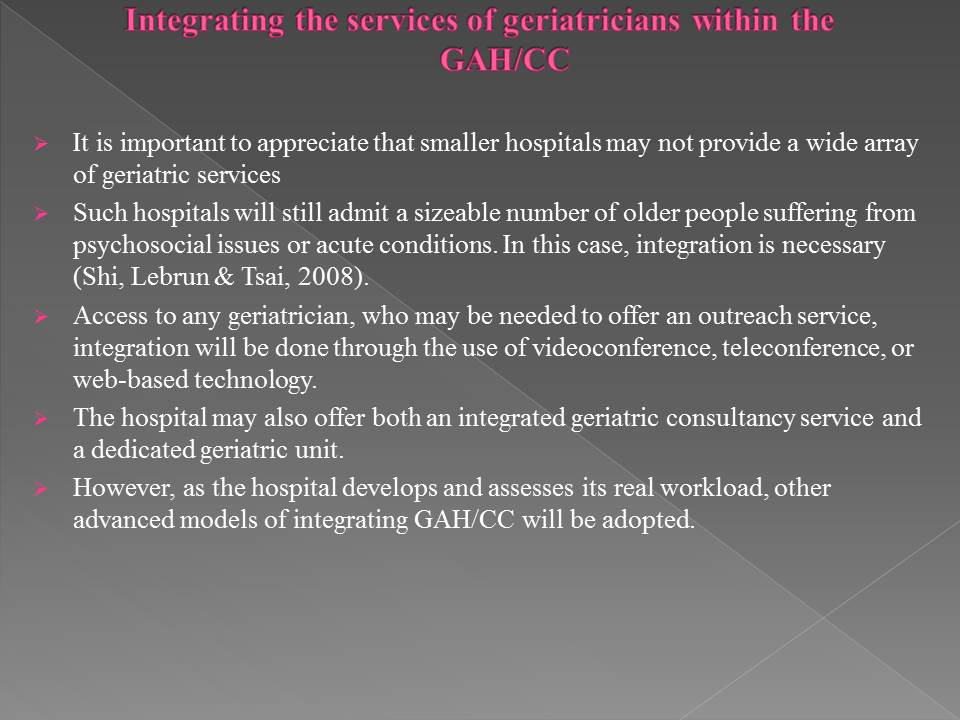
References
Kurtzman, E. (2010). A transparency and accountability framework for high-value inpatient nursing care. Nursing Economics, 28(5), 295-307.
Pitts, S. R., Carrier, E. R., Rich, E. C., & Kellermann, A. L. (2010). Where Americans get acute care: increasingly, it’s not at their doctor’s office. Health Affairs, 29(9), 1620-1629.
Robinson, J. C. (2005). Health savings accounts—the ownership society in health care. New England Journal of Medicine, 353(12), 1199-1202.
Robinson, J. C., & Ginsburg, P. B. (2009). Consumer-driven health care: promise and performance. Health Affairs, 28(2), 272-281.
Shi, L., Lebrun, L. A., & Tsai, J. (2008). US Reforming healthcare delivery. Harvard Health Policy Rev, 9(1), 68-77.
Simonet, D. (2005). Patient satisfaction under managed care. International Journal of Health Care Quality Assurance, 18(6), 424-440.